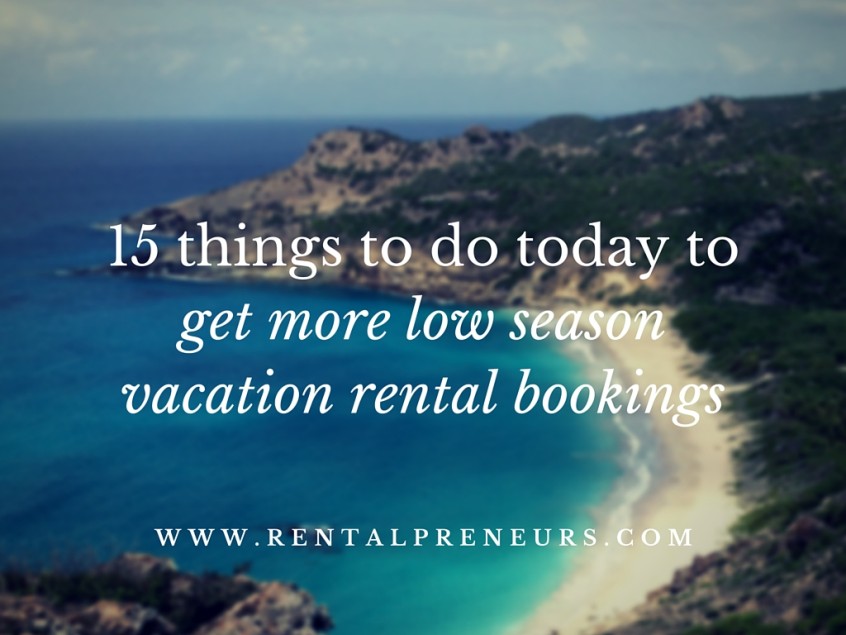When vacation rental owners start looking online for marketing advice, it is often to find ways to increase low season bookings. When owners start talking with vacation rental management companies, it is also with the same question: “Can you get me more low-season vacation rental bookings”?
In order to help you with this dreaded topic, I’ve put together a list of 15 things that you can today to boost your occupancy rate during the slow season.
Study – Determine when it is low season for your rental and who your ideal low season guests are
1 – Determine what low season exactly means for your vacation rental
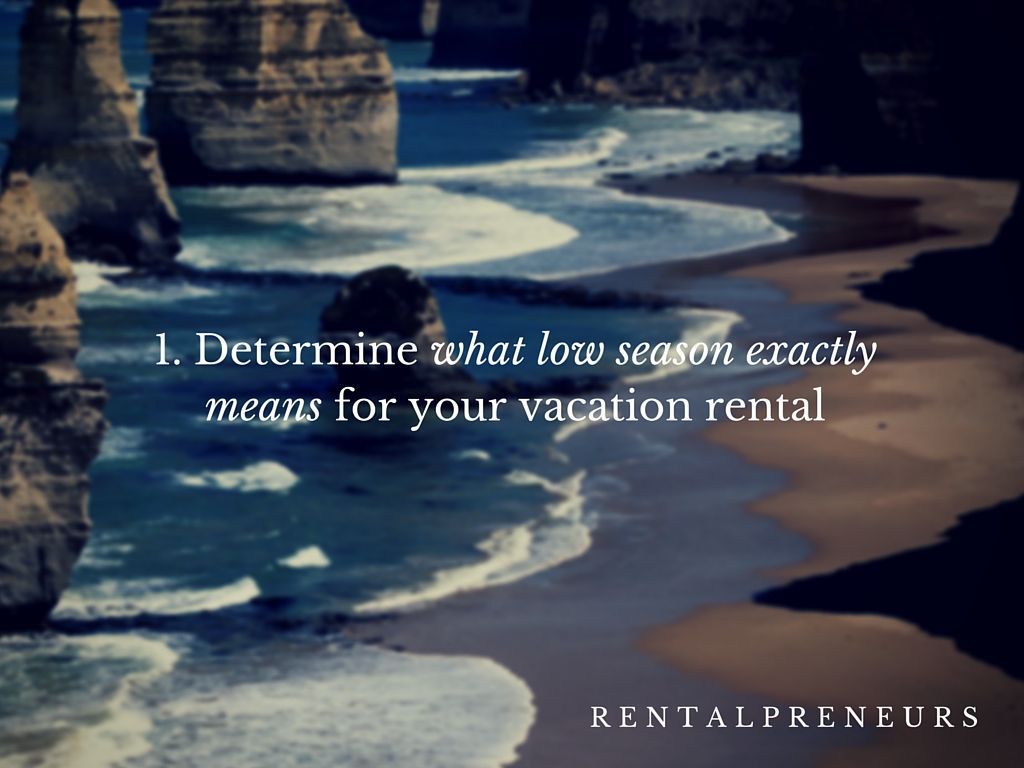
From one location to another, from one type of vacation rental to another, what constitutes the low season seems to vary a lot. I am sure that you have noticed this already when talking with other vacation rental owners.
But what is low season? Sure, high season is when you have a lot of demand, it’s relatively easy to get bookings and you sometimes have to refuse some guests as your rental is full. Good times! Off-season is, well, when you have zero booking, when nobody is asking to stay at your place. Not so good!
Low season is much harder to define: You are getting some bookings, but you are not full. Guests want to stay at your place, but not for your high season rate and sometimes not for as long as during the high season.
In the hotel industry, as well as at vacation rental management companies, there is a sweet spot within low season, called the “shoulder season“. It is defined as the travel season between peak and off-peak seasons, especially spring and fall, when fares tend to be relatively low. This is when you can make a lot of money.
Great, we now have a fancy definition, and we know what low season (and especially the shoulder season) are great times to make money. So it’s time to put all this at work for you. How is it at your own place? Let’s take some examples to guide you.
For instance, in the US, low season starts after Labor Day weekend in places as different as the Hamptons, NY and Myrtle Beach, SC.
My Caribbean island of St. Barths is a winter destination, so low season starts around April 15 and lasts until December 15. However, Thanksgiving weekend is high demand in St. Barths, so I have shoulder rates for that period (i.e. rates higher than the low season, but not as high as the high season).
But low season is also a time when the demand pattern can change: Weekends are still full, but it can become harder to find guests willing to stay during weekdays. In some place, large properties do not rent well at all during the low season, while apartments for couples do really well. How is it, in your area, for your type of rental?
Similarly, you should also remember that some days within the low season can actually be in high demand. For instance, in my home town in East France, it’s always very hard to find a vacation rental available during the first weekend of October. Why? Because hundreds of people gather there to take part in a popular triathlon. And triathletes loves rentals, as they can store their bikes, cook the food they like, and bring their families along to support them. It’s just a better option than booking a cramped hotel room.
So, make sure to check whether popular events will be taking place near your rental during the low season. Do not lower your price too much during these few days of high demand in the low season, as you would be leaving money on the table.
2 – Determine who your ideal low-season guest is

You probably have in mind the ideal guest for your vacation rental. For instance, it could be a family of 4, traveling by car from the US East Coast, who want some special time together as they are all super busy during the rest of the year. Yes, this family may be your ideal guest for the high season, but are you sure that they are the best fit for your rental in the low season as well?
For example, I have a 4-bedroom villa in St. Barths. In the high season, people come and stay for a week, usually as a family of 6 or 7, or as group of 4 couples. However, during the low season, I am ok with offering the villa at different rates if people are booking 2, 3 or 4 bedrooms. I know that outside of the holiday season and of Spring Break, I will not get as many large families or groups. For instance, one of my repeat low-season guests is a TV celebrity who books the villa for 1 month every year to write a new book. It is just the 2 of them for the whole villa and they get the 2-bedroom rate for the whole month.
But this is just one example. Rely on your data. During the previous low seasons, who booked your property? Couples without kids? Retired people looking for some sun? Small biz entrepreneurs looking for an affordable retreat for their executives? How many guests per booking did you get, on average? How many bedrooms did they use? Were you able to upsell some services or packages? Where did most of those low-season vacation rental bookings come from, Airbnb, HomeAway, your website, referrals from previous guests?
Start with understanding who your past guests were, as it will help you define who your ideal low season guest is. Once you know when the low season is and who is coming at your place during this time of the year, you are ready to start adapting your vacation rental marketing to capture more bookings.
Adapt – Change your product ( = your vacation rental) to make it the perfect match for the low season demand
3 – Lower your price … only if it makes sense!

Yes, you do have to lower your rental rates in the low season. But as you will be now have studied the pattern of the demand at your own vacation rental, you now know that you only need to lower your prices when the demand drops. You also know that some weekends, for instance, will be in high demand, so you keep your prices up during those times.
It is time now to look at what others are doing. First, look at how your direct competitors are setting their low season prices. My advice is to go on sites like HomeAway, Flipkey and Airbnb and to find 5 properties that are very similar to yours, that have more than 5 positive reviews and whose calendar seems relatively busy during the low season. These are successful vacation rental owners from who you could learn one or two useful pricing tricks.
What are they doing? How much do they lower their price compared with the high season? 40% less? On weekends as well as on weekdays? Run some tests, enter some dates in the booking engines to see how prices are fluctuating.
To come up with your low season and shoulder rates, test our hotel prices too. Go to Hotels.com and search for prices of hotels nearby your vacation rental. Test out several check-in and check-out dates during the low season. Hotels usually have pretty good yield management tool, so this kind of quick study can give you a good idea of the general shape of the demand.
If you are rental is listed on Airbnb, you can also get price suggestions from Airbnb itself (Go to the property calendar to get them for the upcoming 3 months) and from tools like BeyondPricing and Everbooked.
Whatever the source you are using, always take it with a grain of salt. It’s better to examine data from several sources and to combine the results with you have noticed from your past guests, before deciding on your low season prices. Sometimes, you think that you have to lower your prices a lot in the low season, but you discover that your direct competitors are doing well with reasonable prices. Do your research!
4 – Lower your minimum stay
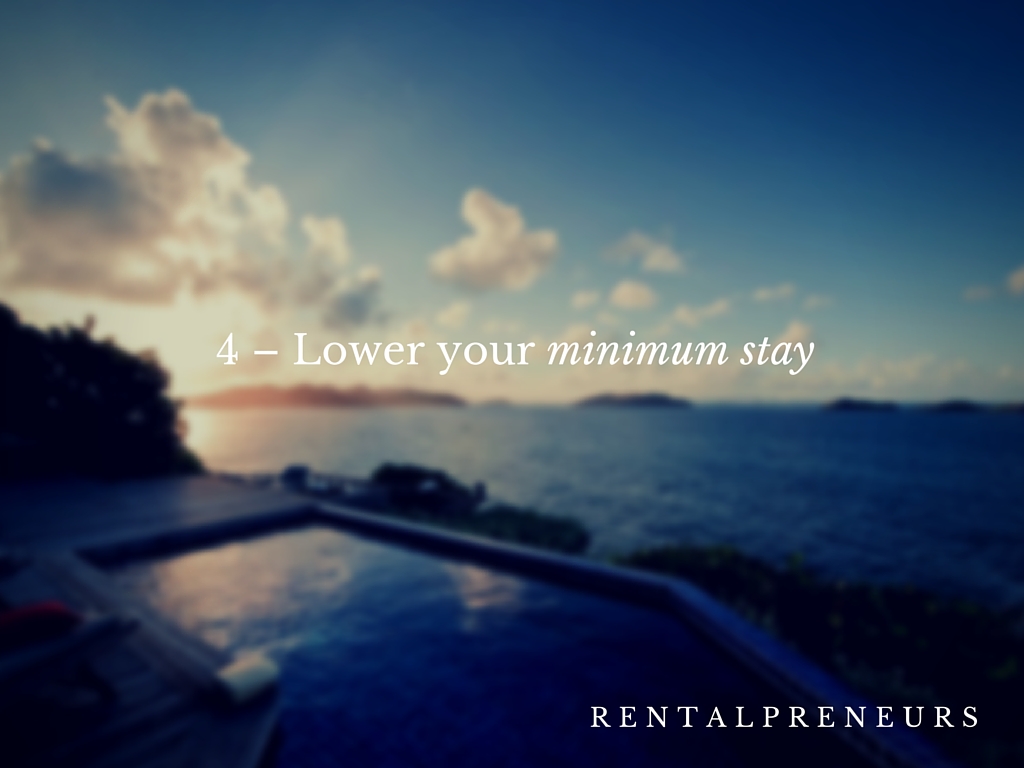
In the high season, you may have a strict 7-night minimum stay policy. But you may consider lowering your minimum stay during the low season and the shoulder season to three nights to accommodate travelers seeking long-weekend vacations.
Again, this depends on your rental, your area and the kind of guests that are targeting.
But you may get away with keeping a premium price at weekends, provided you lower your minimum stay.
5 – Make weekdays attractive

Weekends may still be in high demand, but you may face a problem with weekdays.
How about running special offers for weekdays, for instance by offering 3 nights for the price of 2?
This is another way for you to avoid discounting your apparent price too much and to avoid damaging your image: Keep the same night price, but give away 1 night if people stay for 3 nights during the week.
6 – Close down some bedrooms to attract smaller groups
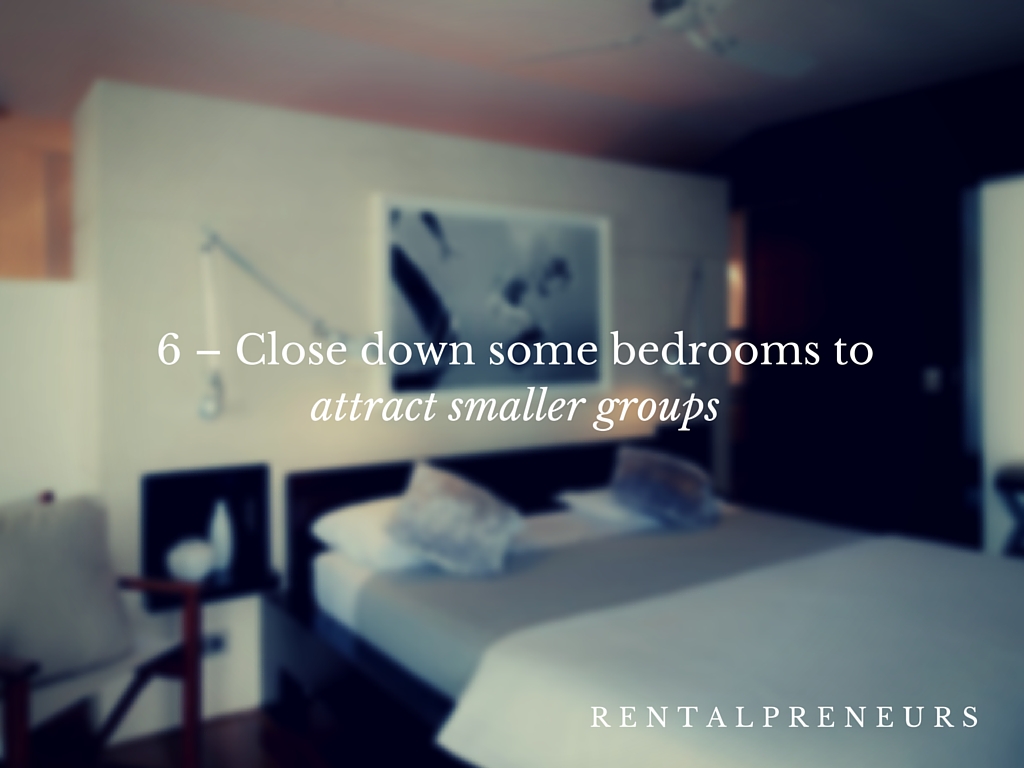
In the low season, it is often harder to rent out large houses than smaller ones. Families are not so numerous, while couples with no kids are more the norm.
Think whether it is reasonable for you to close 1 bedroom or 2, and offer a lower rental price. This is a way of lowering your price without lowering your value too much.
7 – Create packages to get more vacation rental bookings

Another way to avoid lowering your should rates and low season rates too much is to offer more for the same price.
For instance, you may have noticed that, in the fall, you are attracting foodies who enjoy going to from one restaurant to another. How about offering a free meal at nice restaurant next to your rental? Adding a photo of a romantic dinner at a nice restaurant may attract some people.
If there are some local events taking place in the low season, you can also create a package including 2 free (or discounted) tickets to the event.
8 – Add a hot tub … especially if you target couples!

Another to adapt your “product” (i.e. your rental home) is to add a few items that make it more attractive in the low season.
In North America, you could think about getting a hot tub. This is great when the weather gets cold and can be seen as something romantic if couples are your target. A 2014 TripAdvisor study actually lists hot tubs as one of the top 5 luxury amenities that attract travelers.
Believe it or not, adding a hot tub / jacuzzi is also a good strategy if you are targeting couples traveling to a Caribbean island. So, the added value is not completely about that nice hot water …
Deploy – Be proactive and start with the low hanging fruits to make it easy on your vacation rental marketing effort
9 – Contact previous guests

Stop. Do not rush.
Now that you have your pricing order and have even created some offers and packages, it’s time to reach to potential guests.
But start with the most obvious ones. People that know you rental, that know you as a host and whose contacts you already have.
Yes, I am talking about past guests. Even if it is only 30 different people who have booked your rental in the low season over the last 3 years, they are the ones that you should be contacting first.
It will be easy: You have their email address, they know you. Just re-introduce yourself shortly if needed, ask about them. Tell them about your best offer.
This is way faster, less costly and more efficient that trying to go after totally new people who have no idea about you offer.
Your conversion rate should be pretty high if you are in the kind of area where guests can come back to easily.
10 – Ask for referrals from previous guests and make it worthwhile to them
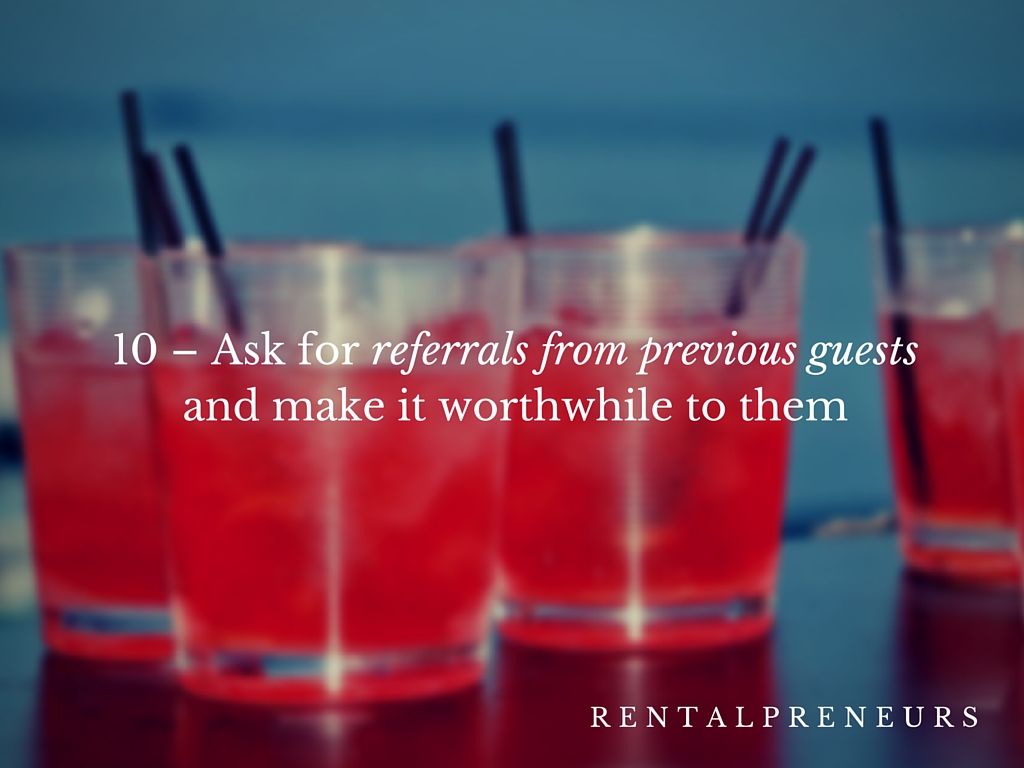
At my Bali vacation rentals, my repeat business is much less than in St. Barths. About 30% of my St. Barths business is made of repeat guests (mostly people from the US East Coast who come every year), while it is only 10% in Bali.
Why? I guess that Bali is a once-in-a-lifetime trip for a lot of people. Once they have crossed it off their bucket list, they move on and explore another place.
Does it mean that I do not write back to past guests? Of course, not! Here, my goals is more to get them to refer my villas to their friends.
Usually, people have fond memories of my luxury beach retreat Bulung Daya, so they tend to mention it to their friends. It is not about boasting, but about sharing a well-kept secret.
So, in my emails, I ask to my past visitors to think about a friend of theirs with whom we could share this secret.
To thank my guests for the referral, I send something nice, like a box of Belgian chocolates or some Champagne.
If you have more repeat business than I do in Bali, you can also promise to give them a discount on their next stay with you if their friends books your rental.
Just make it worthwhile for the previous guests to recommend you and offer something that fits your clientèle.
11 – Contact people who had enquired, but did not book

After previous guests, people who had enquired (but did not book) about your rental make up the lowest hanging fruits.
I am thinking about the kind of people:
– to whom you had to say no last year or the year before, around the same of the year, because your rental was full
– who ended up not coming, for some reason, but were super nice and mentioned that you would maybe book your place in the future
Again, these people know you and you have their email addresses. It did not work out last year or the year before, but maybe all they need is you reminded them about your great vacation rental.
Share with them with the special offer that you created. You are not cold calling them, you are just reconnecting with them with a nice email and an offer.
Do remind them how you got into contact the first time, so that they do not take you for a spammer.
If you want to make the most of these “lost” leads, then you may want to check my INB Tactic online course.
12 – Update your listings
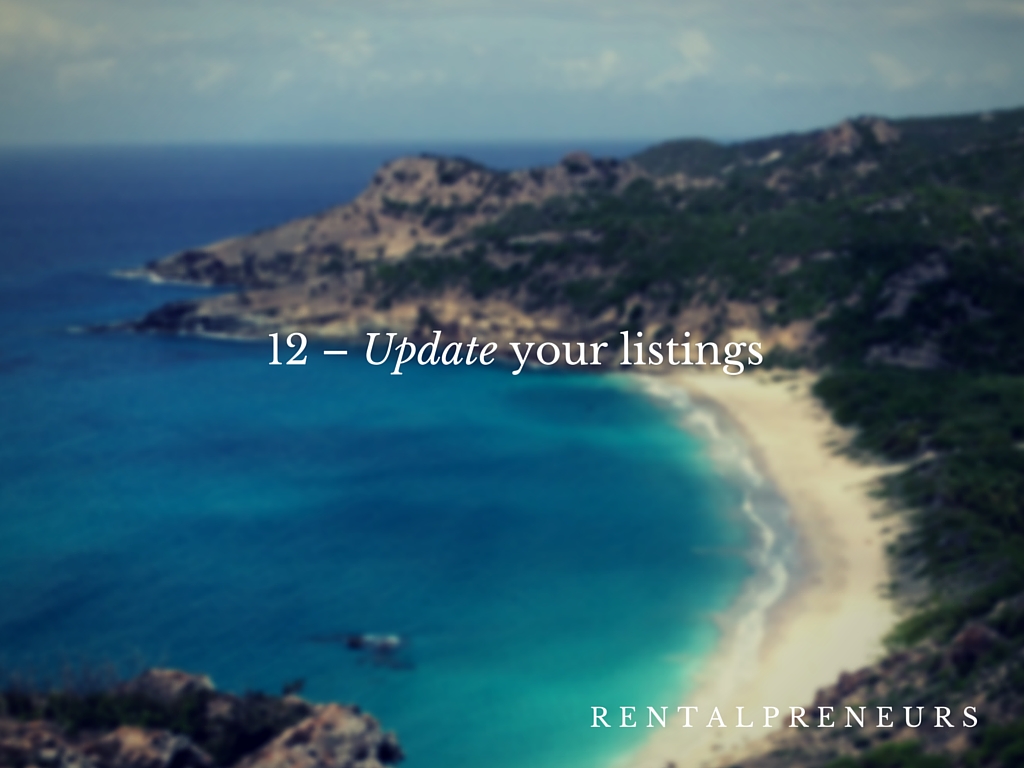
If you are using vacation rental websites such as HomeAway, Airbnb and Flipkey, you need to update your listings to attract low season guests.
If you do only 1 thing, then it should be updating your calendar. First, you want potential visitors to feel confident that your place is available. After the high season, a lot of rental owners do not take the pain of updating their calendars as often. Be different. Second, your listing will rank higher than those of your competitors, as websites like HomeAway reward owners who keep their availability calendar fresh.
Update at least your cover photo, showing how nice your property is during the low season (e.g. trees, fire place, hot tub, etc.). Make it easy for the visitor to imagine what it is like to be there during the slow season.
If you have a special offer, try to feature it into your listing headline. In your listing copy, mention local events taking place during these months near your vacation rental. You can also mention the season specific activities that people can enjoy, such as long walks to look at fall colors (“leaf peeping”).
Do not forget to enter your low season and shoulder rates. Make sure that you are not discounting too much on weekends that may prove popular because of local events.
13 – Try niche vacation rental websites
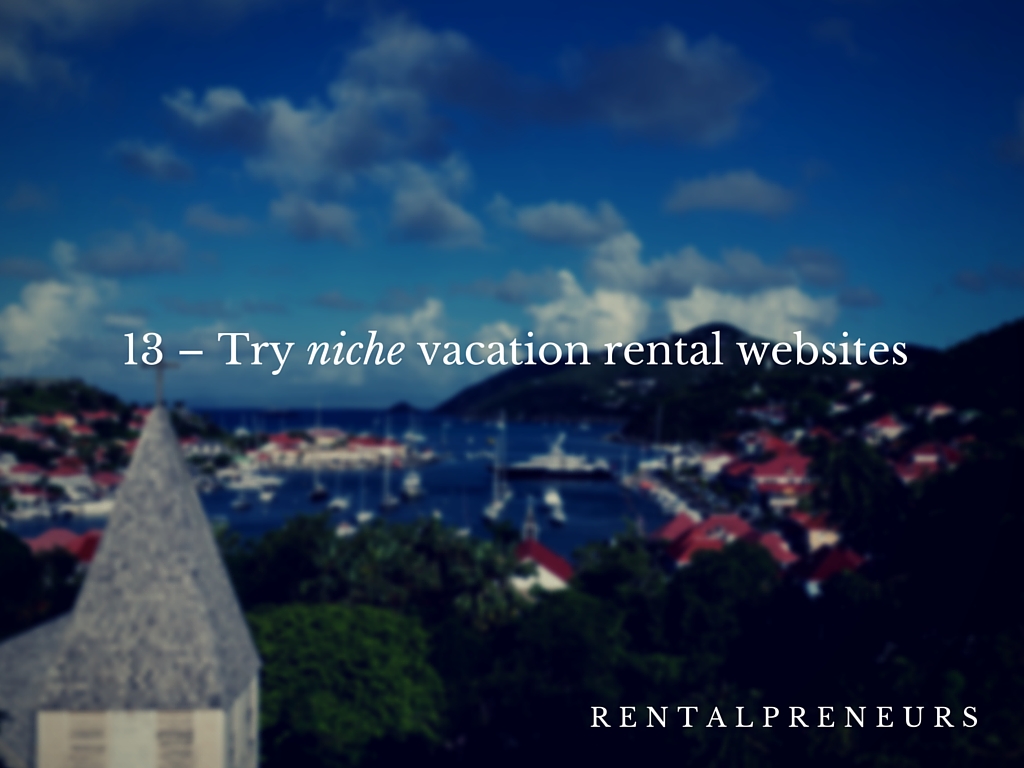
The low season might also give you time to try out new booking channels. If you are already on the major sites, then you can test out niche vacation rental websites.
For instance, have a look at PetsWelcome if you own a pet-friendly vacation rental. If you are in a gay-friendly location, then you may want to list on MisterBnB.
14 – Write a blog post

If you have your own website, you will want to mention your low season and should rates, your special offers, as well as photos that show how great it is to say at your rental in after the peak season.
You may also want to write a blog post such as “7 things that you can only do in (Your Location) in the fall” or “Top 3 reasons to visit (Your Location) in the low season”. This will give ideas to visitors about what they will be able to do while at your place. Share this blog post on social media and send it by email to your past guests.
15 – Contact organizers of local events
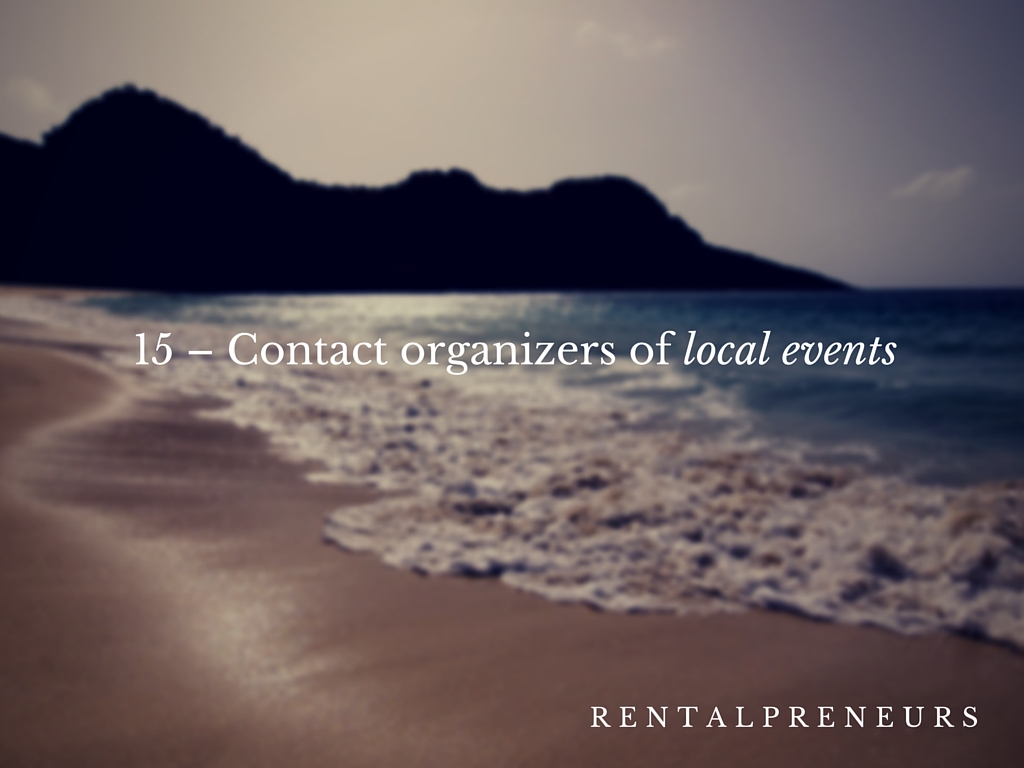
Maybe this will take you out of your comfort zone, but try and call (or visit) the organizers of the local events that you have listed.
They may be thrilled to have somebody care about their event and happy to list your rental in their leaflets and on their website. Maybe you can tell them about a special offer that you are making just for their attendees and that it would be great if they mentioned in their next email newsletter.
Not many vacation rental owners will go that extra mile, so this tactic may be quite successful to fill up a few weekends here and there.
I hope that these 15 things to do to get more vacation rental bookings will be helpful for you. Try and implement at least 1 today, so that you can start getting more low season bookings as soon as possible.
If you have other tactics, please share them with your fellow vacation rental owners in the comment section.

